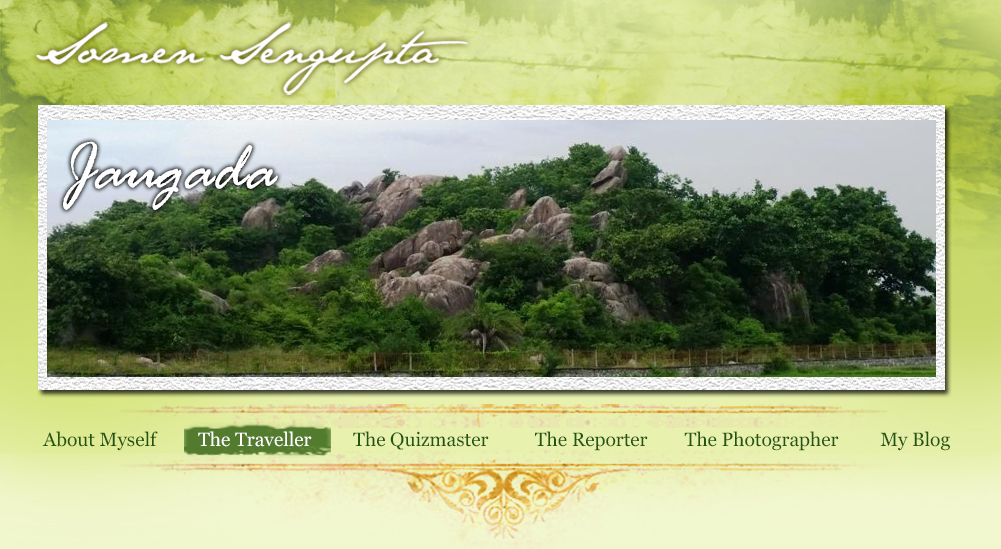CONFESSIONS OF A CONQUEROR |
|
The Jaugada rock edict is one of the earliest relics of mass communication.
Somen Sengupta
Near to the sea mouth of South Orissa’s Ganjam district a beautiful river named Rishikulya flows slowly towards Bay of Bengal.
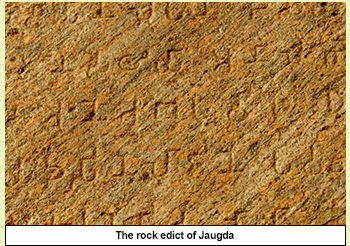 On the bank of this river there stands a village named Purushottampur. The village is connected by motorable road but tough to locate. Even though finally it is found the ordinary looking village makes no significant impression except a mass of rock that towers over the little hamlet. On it’s way from Bhubaneswar almost no one is aware why this rock mass is so important in the history of India. It is only after reaching the village one can see an Orissa tourism sign board that reads “ Ashoka Edicts – Jaugada “. On the bank of this river there stands a village named Purushottampur. The village is connected by motorable road but tough to locate. Even though finally it is found the ordinary looking village makes no significant impression except a mass of rock that towers over the little hamlet. On it’s way from Bhubaneswar almost no one is aware why this rock mass is so important in the history of India. It is only after reaching the village one can see an Orissa tourism sign board that reads “ Ashoka Edicts – Jaugada “.
Even after finding that one has to take many stone stairs to reach at the hill top where except him no one could possibly be seen easily. There inside of an iron cage a massive flank of elephantine boulder to be found on which edicts of Ashoka the king of Magadha who once conquered this land of Kalinga had his declaration of Dharma written more than 2000 years ago in an unique way. This rock edict is one of the earliest relics of mass communication written on stone.
The extreme oblivion and negligence found in Jaugada where a piece of our history rests in dark is an evidence of our character that shows no respect to our heritage.
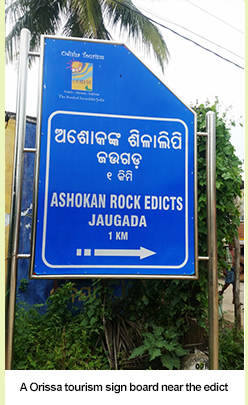 More than 200 years ago before European freelancing archeologists and antiquarians started showing their hard work and passion to rediscover India’s pre-islamic heritage we Indians were happily settled with Taj Mahal and Red fort thinking beyond these there was no India before. More than 200 years ago before European freelancing archeologists and antiquarians started showing their hard work and passion to rediscover India’s pre-islamic heritage we Indians were happily settled with Taj Mahal and Red fort thinking beyond these there was no India before.
Things changed from mid of 18th century when British East India Company slowly started conquering political power.
It all started when Sir William Jone’s established Asiatic Society of Bengal in Calcutta where ancient India was rediscovered through nonstop sight expedition and bone breaking hardworks of many people who were all so called foreigners.
One such person was James Prinsep who came to India in 1819 and by 1835 he was the life of Asiatic Society.
Through an excellent network with various employees of East India Company and other European traders James had started collecting different form of a mysterious language found on the pillars and rock beds across India and Afganisthan. In 1837 James played a master stroke of his brilliance to decode a language named Magadhi Prakrit written in a script of Bramhi and Kharoshthi which were Indian but not known to Indians for more than 2000 years.
Captain Markham Kittoe the coal agent of East India Company who had the credit of finding Dhauli rock edict that helped James to decode Magadhi Prakrit was also the first person who mentioned about another rock edict at Orissa’s Jaugada sometimes in 1830s but failed to locate it physically. He wrote to James Princep in Calcutta that this rock has “an inscription covering 270 sq ft.”
James unfolded the mystery of Ashokan edict in 1837 with other elements collected from Gujarat, Delhi and Bihar. He soon fallen seriously ill.
So Jaugada edict as a subject took a back seat in Asiatic Society.
In 1854 when south of Orissa was still under Madras Presidency Walter Elliot another East India Company official visited the place with one IAS officer and committed an unpardonable sin though his intention was not evil.
Out of his excitement he tried to copy the alphabets of rock edicts and in process of that he poured hot tamarind juice and beat the same with hammer. As a result a large portion of the external rock was broken aborting many important information. However with enough reason Walter Elliot who was famed in discovering Amaravati stupa in South India never mentioned about his discovery of Jaugada and it’s partial destruction.
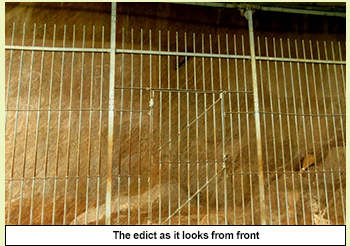 In 1872 it was first officially reported by W F Grahame a district official. By that time the existence of Ashoka the Devanamapiyadasi was cemented in Indian history and James Prinsep who was behind that was dead in England. In 1872 it was first officially reported by W F Grahame a district official. By that time the existence of Ashoka the Devanamapiyadasi was cemented in Indian history and James Prinsep who was behind that was dead in England.
Considering it’s size and content this newly found Jaugada was counted as one of the major Ashokan rock edict found in the sub continent till this day. Some of the other major rock edicts were found in Girnar of Gujarat , Dhauli of Orissa , Kalsi of Uttarakhand , Shahbazgarhi of Pakistan etc .
Along with 9 major monolithic pillars with rock edicts rediscovering Buddhism and existence of a king named Ashoka was possible. The first tangible evidence of Budhism and it’s expansion by Ashoka was never possible if one after another edicts on rock and pillars were not found and decoded.
Once it’s existence of Ashoka was established scholars started reading the edicts of Jaugada and the finding was jaw falling.
It was no way similar to other rock edicts found but almost exactly similar to another rock edict found in Dhauli of Orissa. This gave birth of a new kind of Ashoka rock edict named Kalinga edicts.
Both the Kalinga rock edicts contain separate edicts and both do not contain a specific common edict commonly found elsewhere. It is to note that both Dhauli and Jaugada are in Orissa which was ancient Kalinga a kingdom attacked and plundered by Ashoka’s soldiers.
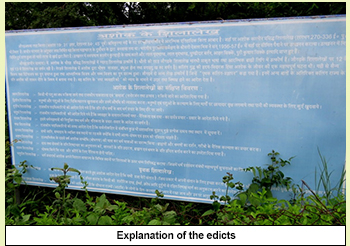 While Dhauli in northern Orissa was known as Toshali in Ashoka’s time ( 304 BC to 262 BC ) the Jaugada in south was known as Samapa in the same time. While Dhauli in northern Orissa was known as Toshali in Ashoka’s time ( 304 BC to 262 BC ) the Jaugada in south was known as Samapa in the same time.
Out of 14 edicts found on the rock of Jaugada edict 1 to 10 are common with all other edicts found elsewhere however with some very well calculated political gambit creators of this public declaration mode replaced edicts no 11 to 13 where Ashoka’s brutal and gory conquest of Kalinga and his subsequent remorse at the suffering of people are scripted.
This was exactly done in other rock edict found in Dhauli of north Kalinga a land that saw Ashoka’s inhuman side as an imperial warmonger. It is clear that with specific political agenda Ashoka’s administration did their best to make people forget the unimaginable brutality caused by Ashoka’s army in Kalinga war. Noted historian Charles Allen very rightly evaluated this by saying “ In Kalinga itself those remarks had been deliberately omitted”.
In that place of 3 missing edicts 2 new edicts are inserted to spread Ashoka’s famous doctrine of Dharma. These 2 newly inserted edicts are known as separate rock edicts. In one of that an appeal is circulated to Mahamartyas special religious officers of Toshali old name of Dhauli and Samapa old name of Jaugada to involve themselves in spiritual welfare and impartiality to subjects so that they can live in peace.
In other newly added edict reforms instituted by Ashoka are expressed by assuring people to live without fear and to practice the Dharma of forgiveness. It also says that King is like a father to subjects and subjects are his own children.
It is interesting to note that Jaugada geographically comes in south of Kalinga a territory Ashoka did not conquer in war. So his intention shows to win over people through this kind of message. This was a new style of diplomatic expansion introduced by a very intelligent chamber of politicians.
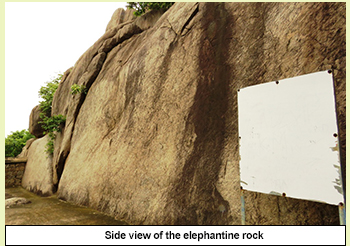 Baring these all other rock edicts are typical of Ashokan’s doctrine of spreading Buddhism through peace and tolerance. They talk about prohibition of animal slaughter, disapproval of individual fame and glory, kindness to slave, Ashoka’s pilgrimage to Bodh Gaya , tolerance for all religion etc. Baring these all other rock edicts are typical of Ashokan’s doctrine of spreading Buddhism through peace and tolerance. They talk about prohibition of animal slaughter, disapproval of individual fame and glory, kindness to slave, Ashoka’s pilgrimage to Bodh Gaya , tolerance for all religion etc.
In his 1858 excavation Elliot found many currency coins of Kushana era of 1st century. In 1956-58 another excavation under Mrs Debola Mitra of Archaeological Survey of India unearthed many more artifacts proving this place as a booming Ashokan era city. RK Gopal Bhandarkar of Bombay University also contributed richly in Jaugada rock edict saga.
Today Jaugada is perhaps the most forgotten rock edict of Ashoka though it is exceptional in it’s content and huge in it’s size.
Though ASI has done a good job by installing an iron cage before it but still mark of vandalism is palpable on it’s surface. The place is badly guided but the path upwards the hill is very well built. The patch of negligence is so pathetic that sign boards describing the history, importance of the place and explanation of every edicts are faded beyond legibility and almost banished in wild vegetation. One needs to risk his safety to read these boards. The area is unmanned and to make the sight ugly broom and other cleaning tools are kept under the rock itself.
Just few km from this a Shaktipith temple daily draws huge number of crowd and religious fairs are organized frequently while this gem of India’s ancient history gathers dust and omission.
In this country heritage always gets defeated by religious sentiment.
Doubtlessly that is a tragedy.
This article was published in The Tribune on 12th July 2020.
Click here to view the original article
|
